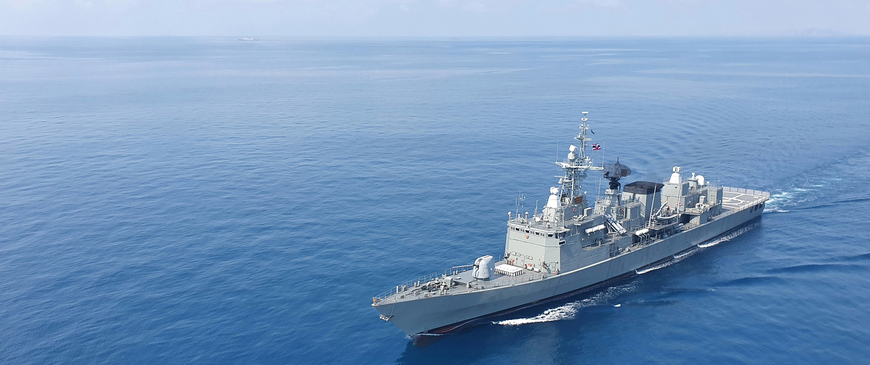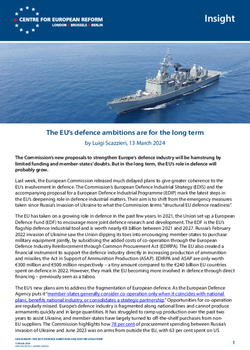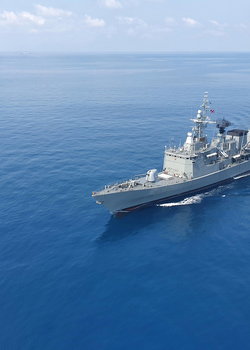
The EU's defence ambitions are for the long term
The Commission’s new proposals to strengthen Europe’s defence industry will be hamstrung by limited funding and member-states' doubts. But in the long term, the EU’s role in defence will probably grow.
Last week, the European Commission released much delayed plans to give greater coherence to the EU’s involvement in defence. The Commission’s European Defence Industrial Strategy (EDIS) and the accompanying proposal for a European Defence Industrial Programme (EDIP) mark the latest steps in the EU’s deepening role in defence industrial matters. Their aim is to shift from the emergency measures taken since Russia’s invasion of Ukraine to what the Commission terms “structural EU defence readiness”.
The EU has taken on a growing role in defence in the past few years. In 2021, the Union set up a European Defence Fund (EDF) to encourage more joint defence research and development. The EDF is the EU’s flagship defence industrial tool and is worth nearly €8 billion between 2021 and 2027. Russia’s February 2022 invasion of Ukraine saw the Union dipping its toes into encouraging member-states to purchase military equipment jointly, by subsidising the added costs of co-operation through the European Defence Industry Reinforcement through Common Procurement Act (EDIRPA). The EU also created a financial instrument to support the defence industry directly in increasing production of ammunition and missiles, the Act in Support of Ammunition Production (ASAP). EDIRPA and ASAP are only worth €300 million and €500 million respectively – a tiny amount compared to the €240 billion EU countries spent on defence in 2022. However, they mark the EU becoming more involved in defence through direct financing – previously seen as a taboo.
The EU has taken on a growing role in defence in the past few years.
The EU’s new plans aim to address the fragmentation of European defence. As the European Defence Agency puts it “member-states generally consider co-operation only when it coincides with national plans, benefits national industry, or consolidates a strategic partnership.” Opportunities for co-operation are regularly missed. Europe’s defence industry is fragmented along national lines and cannot produce armaments quickly and in large quantities. It has struggled to ramp up production over the past two years to assist Ukraine, and member-states have largely turned to off-the-shelf purchases from non-EU suppliers. The Commission highlights how 78 per cent of procurement spending between Russia's invasion of Ukraine and June 2023 was on arms from outside the EU, with 63 per cent spent on US equipment alone. These purchases do little to increase the EU’s domestic production capacity and mean that European countries are very reliant on third-country suppliers. The Commission would therefore like member-states to spend 50 per cent of their procurement budgets on EU kit by 2030, rising to 60 per cent by 2035 – a challenging target to reach.
Fostering joint planning and focusing EU funds
Co-operation starts from joint planning, and existing EU tools to encourage this, such as the Co-ordinated Annual Review on Defence, are not sufficiently embedded in national defence budgeting and procurement plans. And, while many EU countries are NATO members, the alliance’s planning tools are not focused on fostering co-operation, nor do they set targets for what European allies should be able to do collectively.
The Commission aims to remedy this through EDIP. It wants to establish a European Defence Industrial Readiness Board, bringing together the member-states, the High Representative, the European Defence Agency and the Commission. The Board would be flanked by a European Defence Industry Group to ensure industry is heard. The Board is meant to bring together key defence players in a structured and predictable format, encouraging them to work together more. For example, the Board should further define capabilities on which co-operation is most promising; exchange information on production capacity and supply chains; and monitor flows and stocks of critical products and raw materials.
The Board would not have a transformational impact on defence planning. It could only recommend and perhaps cajole. But it would be useful in pushing defence co-operation higher up the EU agenda and building working relationships and trust in an area where national instincts normally prevail. The Board could also help the EU in identifying priorities to focus on. The Commission thinks some of the most promising are those which are beyond the means of single member-states, such as a cyber shield; an integrated European air and missile defence system; sensors to detect and tools to respond to space threats; and the protection of critical infrastructure, including subsea infrastructure.
New incentives for member-states to co-operate
One of the core elements of EDIP is to offer financial and regulatory incentives to encourage member-states to work together. EDIP will build on EDIRPA, providing financial support to co-operative procurement programmes. However, whereas EDIRPA focused only on urgent needs, EDIP will broaden the net.
One of the core elements of EDIP is to offer financial and regulatory incentives to encourage member-states to work together.
As a further incentive, EDIP proposes a new concept – the so-called Structure for European Armament Programme (SEAP). Member-states would band together to co-operate within the framework of a SEAP, which would be an organisation of its own. Projects taking place within a SEAP would be eligible for funding bonuses. For example, if countries agree to own equipment bought through a SEAP jointly they would receive a bonus from EDIP. SEAP projects would also receive a bonus if participants agreed on a common approach to exports – the lack of which often poses a barrier for common armaments projects. It is unclear whether these measures will be enough to persuade member-states that joint procurement through the EU is worth the loss of flexibility and the added bureaucracy. Unless there are substantial financial incentives, many are likely to prefer other formats – at least until the EU has built up a track record of procurement.
EDIP also contains a set of measures to encourage member-states to buy equipment made in the EU. The Commission wants to establish a catalogue of EU kit, voluntarily provided by member-states, to highlight what is available. The Commission would also like to fund the stockpiling of additional armaments within the framework of a SEAP, so more kit could be available for sale beyond what was initially ordered. The Commission has also proposed to introduce the option of an ‘open’ regime for defence contracts. That would allow member-states to more easily join existing procurement contracts on the same terms as the original customers. Many of these proposals are likely to be controversial with the member-states: it is unclear how add-on orders by the Commission could work, and who would own the stockpiles.
An EU security of supply strategy
EDIP contains measures to ensure that EU defence companies can ramp up production capacity quickly – and maintain it even in difficult conditions. EDIP will extend the logic of ASAP beyond ammunition and missiles to other capabilities, specifically those that are expendable. EU funding will be used to cover eligible costs, such as new plants, machinery and personnel costs. The EU also proposes to fund the stockpiling of strategic components such as electronics.
EDIP proposes a toolbox of crisis measures, similar to America’s Defence Production Act, that can be triggered by a qualified majority vote of member-states. If a crisis is declared, the Commission would be able to force firms to share sensitive information about their production capacity and oblige manufacturers of civilian equipment to repurpose their supply lines to produce defence materiel. In a declared state of crisis, it would also be harder for member-states to impose restrictions on the flow of military components across the EU – a measure the Commission sees as necessary to ensure supply chains are resilient. These measures are controversial: member-states have rejected analogous powers for the Commission in the negotiations over ASAP.
Finally, EDIP aims to improve defence firms’ ability to borrow. The Commission wants the European Investment Bank (EIB) to invest in defence, going beyond its current mandate which only allows lending that relates to dual-use equipment. However, any decision to broaden the EIB’s mandate is up to the member-states, who will have to agree unanimously. The Commission also addresses complaints from defence industry that rules on sustainable investment may scare lenders away from funding defence, stating “no EU rule, or any EU planned rule, impedes private investment in the defence industry.” For its part, the Commission proposes lending its own funds to the defence industry, for example giving interest-free loans to firms to build prototypes of equipment.
Ukraine and other non-EU countries
One of the key aims of EDIP is to support Ukraine and integrate it into Europe’s defence industrial base. Ukraine could benefit from proposed EU funding under EDIP, meaning that EU funds could support the strengthening of its defence industry. Ukraine could take part in the proposed SEAP and be invited to the European Defence Industrial Readiness Board. The EU also plans to open an innovation office in Ukraine, to act as a link between EU defence start-ups and Ukraine’s defence needs. Ukraine will not have to contribute financially to EU tools, placing it in a unique position among third countries.
One of the key aims of EDIP is to support Ukraine and integrate it into Europe’s defence industrial base.
Like its predecessors, EDIP envisages that Norway, as an associated country, can participate on near-equal terms to the member-states. Conversely, EDIP maintains its predecessors’ closed approach towards non-associated third countries, such as the UK. Their subsidiaries in the EU can participate and even access EU funding, but only if they are essentially ‘firewalled’ from their parent company and country – with limited ability to extract intellectual property or sensitive information. The rule that products developed with EU funding cannot be subject to third-country restrictions on use (which includes export controls) will also continue to be an obstacle to their participation.
In principle, member-states can also involve non-EU entities in EU funded projects. Understandably, they would not benefit from any EU funding. But the bigger block is that the current rules around intellectual property and export restrictions make participation unfeasible. Over time, that is likely to lead to an erosion of co-operation with non-EU partners, particularly if EU tools develop momentum.
Looking ahead
The EU’s proposals will have to work their way through the EU legislative process before they become law. Negotiations are unlikely to start until after a new Commission is in place at the end of the year, so EDIP will probably not materialise until 2025. It will not make a difference in the short term to increasing production for Ukraine or strengthening European deterrence.
Beyond that, the most immediately obvious issue with EDIP is funding. While internal market commissioner Thierry Breton had talked of a €100 billion defence fund, EDIP’s budget is a paltry €1.5 billion. In effect, EDIP is a bridging measure, refinancing EDIRPA and ASAP beyond their expiry in 2025 until the next EU multi-year budget starts in 2028. Additional funding from the EU budget is not possible within the current seven-year EU budget cycle. Joint borrowing for defence, which France has long been advocating, seems unlikely in the near term. While some frugal states like Estonia and even Denmark seem open to it, Germany and the Netherlands remain opposed. Last year’s ruling by Germany’s Constitutional Court that the EU’s post-pandemic recovery fund was a one-off stands out as a particular challenge. Nevertheless, there may be an additional injection of funding from the profits earned on Russia’s frozen assets, which amounted to around €4 billion in 2023 and which the Commission wants to use to strengthen EDIP. The EU may also be able to draw on other instruments to finance defence. For example, the Commission says structural funds could be used to finance efforts to expand production capacity – an idea that some member-states could take up.
A separate question is whether member-states can be persuaded of the merits of the Commission’s ideas. The proposed subsidies will be welcomed by the likely beneficiaries of funding, but some countries are likely to question why they should essentially subsidise the biggest member-states with the largest and most competitive defence firms. The Commission’s proposals relating to security of supply and procurement will be controversial and some countries could see them as a power grab. Some countries, including Sweden, will push back against the Commission’s very restrictive approach towards third country participation, rightly arguing that excluding important partners like the UK does not make sense. Finally, the idea that the EU could become directly involved in procurement by building stockpiles of components and military kit will probably be a bridge too far for most member-states, as that could pave the way for EU-owned capabilities and EU arms sales to third parties.
Notwithstanding these question marks, it seems likely that the EU’s role in defence industrial matters will slowly deepen. The prominence of defence issues on the EU’s agenda has greatly increased. Commission President Ursula von der Leyen’s idea of having a Commissioner dedicated to overseeing the Union’s defence industrial tools is picking up steam. The EU is already an established actor in defence research through the EDF, and its expertise in this area will grow. The question is whether the EU can be more than that. EDIP would make the EU an actor in terms of facilitating the expansion of industrial capacity and fostering joint procurement in some areas. If the EU developed a track record of successful procurement projects, that would probably lead to greater appetite for its involvement.
It seems likely that the EU’s role in defence industrial matters will slowly deepen.
The current trajectory of slowly increasing EU involvement in defence industrial matters could be accelerated by external events. The possibility of Ukraine’s defeat has already given EU defence debates greater momentum. A Trump victory in the US presidential election in November will worsen fears that Ukraine will be overrun and that an emboldened Putin could then test NATO’s defences. That might be enough to persuade Europeans that it is time for greater investment in EU defence tools.
Luigi Scazzieri is a senior research fellow at the Centre for European Reform.



Add new comment